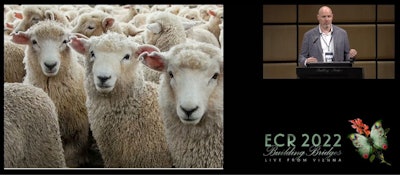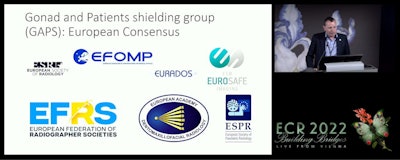
European experts are gradually reaching a consensus that radiation shielding is no longer needed for some imaging exams, yet this notion is proving a hard pill to swallow at some hospitals. With that in mind, a panel discussion held on Friday at ECR 2022 in Vienna addressed the pros and cons of the issue.
"To shield or not to shield? That is the question. It sounds like Shakespeare, but it's about imaging," said Graciano Paulo, PhD, of Coimbra Health School in Portugal, who chaired the panel.
Earlier this year, the Gonad and Patient Shielding (GaPS) Group, a group representing Europe's major radiation safety societies, recommended discontinuing radiation contact shielding for patients in a majority of cases. Essentially, the GaPS members found that technological advances in imaging have reduced radiation doses to levels where the practice is no longer necessary.
Paulo, who also heads the Collaborating Center for Radiation Protection and Health at the World Health Organization (WHO), introduced two Irish experts who presented opposing views on the issue.
Arguing for keeping patient radiation shielding was Mark McEntee, PhD, professor and chair of diagnostic radiography at University College Cork in Ireland. His colleague, Paddy Gilligan, PhD, chief physicist at Mater Misericordiae University Hospital in Dublin and chair of the GaPS group, then offered his perspective on why the group made its recommendation.
Should it stay?
McEntee said he believes patient shielding continues to be needed. He said he has been studying the issue for about 20 years, with more than 250 peer-reviewed articles published on the topic, mostly regarding radiation dose optimization.
"Just because there are guidelines doesn't mean they are correct. In fact, it is your professional responsibility to make appropriate decisions for each patient, each time," he noted.
 Mark McEntee, PhD, during the debate at ECR 2022.
Mark McEntee, PhD, during the debate at ECR 2022.McEntee said the issue is one of autonomy. Radiographers are already required by European law to reduce radiation doses to patients to levels as low as possible, and removing an optimization tool they use for that purpose hampers their abilities to do their jobs, he said.
Moreover, the use of shielding reduces patient anxiety, McEntee said. When patients find out radiologists are not doing everything that they can to reduce their risk, it will not go well for the profession, he said.
In addition, studies suggest radiation doses in patients have indeed been reduced during individual examinations by a factor of two since the 1980s, but that is not the whole picture, McEntee said. He said cumulative effective dose is actually increasing in patients worldwide, including in children, due to more complex imaging exams, and he cited several studies.
Ultimately, even doses that are considered "negligible" still carry risk, McEntee said. Radiation is still a carcinogen. There is no proven threshold below which radiation does not cause cancer, and the linear nonthreshold model should still hold. Solid cancer can occur from between zero and 200 mGy, with a 1% chance of fatal cancer proven at a dose of 200 mGy, he said.
"It's not horrific to consider getting rid of lead, but it is one of our tools. Which other tool will be next? I say keep all of the tools we can use, and make choices," he concluded.
Should it go?
Patient contact shielding tools are made in his hometown in Ireland, said Gilligan, providing a tongue-in-cheek conflict of interest statement. However, he said the GaPS recommendation was based on an extensive review of scientific studies that suggest the practice simply is not effective anymore.
 Paddy Gilligan during his presentation at ECR 2022. He is also president of the European Federation of Organisations for Medical Physics (EFOMP).
Paddy Gilligan during his presentation at ECR 2022. He is also president of the European Federation of Organisations for Medical Physics (EFOMP).Patient contact shielding was introduced at a time of different technology and radiation doses than are seen today, and indeed there were benefits, including reductions in absolute dose. Yet between 2009 and 2019, numerous papers have countered these risks, with studies now identifying downsides to patient contact shielding, such as the following:
- Difficulty placing the shields over organs of concern
- Discomfort experienced by patients
- The presence of artifacts
- The potential for interference with automatic exposure control
- Cost
In addition, there is a growing body of evidence that patient contact shielding is ineffective and at times potentially hazardous, and therefore the use of shielding may provide false assurance to staff and patients. Published evidence suggests that exposure controls on x-ray machines can in fact increase radiation to other parts of the body in an effort to "see through" the lead.
Specifically, this may be true in applications such as breast, eye lens, and embryo or fetal contact shielding both inside and outside the field of view (FOV). Importantly, however, Gilligan said the recommendations don't suggest ditching all contact radiation shielding. The GaPS group suggested thyroid contact shielding may still be used inside the FOV in cephalometric radiology and outside the FOV in dental x-ray and cone-beam CT.
"The consensus basically says that we would not recommend shielding apart from a few cases of dental radiology," he said.
Ultimately, the GaPS recommendation was simply the first step of a larger initiative, Gilligan said. The GaPS group heeded the fact that for some users of radiation, implementing the recommendations may represent a significant cultural change in practice and require development of a change management program, with stakeholder consultation.
To that end, the GaPS group has now moved on to reviewing current practice throughout Europe and will be providing suitable information and education material for health professionals and the public.
Paulo closed the session by noting that radiation contact shielding is just one factor involved in protecting patients from radiation doses. In many departments, the dose can increase among radiographers performing the same x-ray procedure, he said.
"I would challenge the scientific committee for ECR 2023 to bring this into the debate because [shielding] is only one piece of the puzzle," he concluded.



















